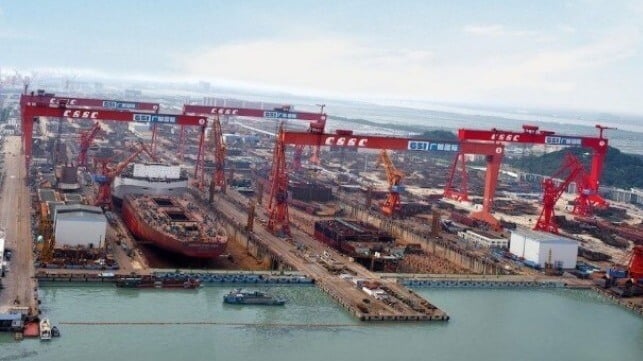Forecast: China is Taking Steps to Dominate Shipbuilding for Decades

China is plotting to dominate the shipbuilding industry for decades to come says Greek shipbroking and shipping services firm Intermodal Group. In a new analysis of the shipbuilding industry, Intermodal highlights the reopening of numerous dormant shipyards and the expansion of existing facilities capacity as China moves to solidify its long-term leadership in shipbuilding.
Among the steps that the analysis points to for confirmation of the long-term strategy is shipyard reactivation. Among the notable revivals, they highlight that Jiangsu Rongsheng Heavy Industries is coming back to life after 10 years of inactivity. Rongsheng was founded in 2006 and became the largest private shipbuilder in China, churning out giant Valemaxes at its four large drydocks before a massive financial collapse forced it to cease operations in 2014. The yard is now being reactivated with Mediterranean Shipping Company (MSC) being among its first clients. Last month, it secured an order for 11,500 TEU LNG dual-fueled vessels from MSC. Other shipyards including Hengli Heavy Industry, Yangzhou Guoyu Shipbuilding, and Dalian Shipbuilding Offshore have also restarted operations.
China’s pursuit of dominance goes beyond yard reactivation the report highlights as companies including New Times Shipbuilding, Wuhu Shipyard, and Nantong Xiangyu Shipbuilding are among the yards that have expanded their production capacity.
“This growth of shipbuilding capacity is expected to absorb a part of the excess demand, reducing vessel delivery times,” notes Intermodal.
The outcome is evident with Chinese shipyards managing to capitalize on the current demand that has seen shipping lines replace aging tonnage with energy-efficient newbuilds. China has steadily increased its share of the global orderbook surging by nearly 41 percent from 3,591 vessels to 5,049 over the period between 2021 and November of this year.
China has rapidly emerged as a market leader in global shipbuilding eclipsing former market contenders including Japan and South Korea. At the same time, it has created a growing uneasiness with Western governments such as in the United States and Canada where there are repeated accusations of unfair trade practices and state subsidies for the industry from the Chinese central government.
Currently, China commands nearly 65 percent of global shipbuilding orders, a significant rise considering its less than 10 percent share in 2000. Its main competitors, however, have witnessed a steady plunge in orders. Since 2000, the combined orderbook share of Japan and South Korea has declined from 78 percent to 31 percent.
As of November, Chinese shipyards boasted an orderbook of 3,256 vessels comprising 224 million dwt, marking a 37 percent increase from 2023, while the global order book only grew by 21 percent. China’s share is up by 72 percent from 2022. China is leveraging new technologies, low labor costs, and large-scale production capabilities.
Intermodal highlights that in the realm of new contracts, Chinese shipyards remain dominant, securing 1,338 vessels totaling 103.9 million dwt, which represents 70 percent of all new contracts. The yards have captured 89 percent of containership orders, 81 percent of bulk carrier orders, and 74 percent of tanker contracts.
“China has successfully leveraged partnerships with international firms, facilitating the transfer of valuable expertise, enabling it to advance in the construction of more sophisticated vessels such as chemical tankers or gas carriers,” notes Intermodal.
The broker adds that domestic demand for both new ship construction and repair services is also a key driver for the booming shipbuilding industry in China. The domestic fleet accounts for approximately 13 percent of global tonnage.
“In the current global shipbuilding market, the robust demand for new vessels, evidenced by a steadily growing order book in the post-COVID era and rising new building prices, are expected to drive further expansion of the Chinese shipbuilding sector and maintain its leading position,” states Intermodal.
South Korea which recently has been China’s main rival has changed its strategy to focus on high-value orders ceding most containership and bulker orders to China. Instead, it looks to maintain its market position by focusing on emerging categories such as ammonia-fueled and new technologies for automation and autonomous ships.
